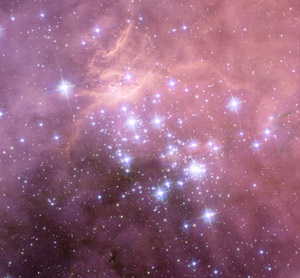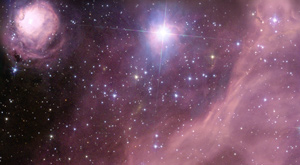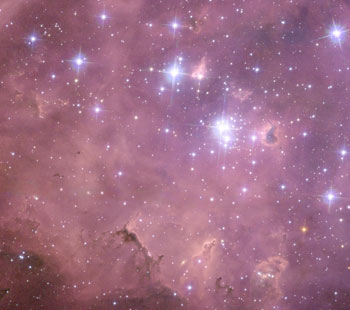Deep inside the Milky Way’s companion galaxy called the Large Magellanic Cloud lies a vast complex of stars, gas, and dust. From our vantage point, 170,000 light years away, we see it as a softly-glowing pinkish brain-shaped cloud studded with stars – a description that grossly underdescribes the tremendous beauty of the newly-released Hubble view of it:
Oh, my. Click it to get a bigger version, or go here to get a 26 Mb 4000x4000 pixel version.
 What a staggeringly lovely image! And so much to see. More than you’d expect… but that’s part of a surprise I’ll have for you at the end of this post. Bear with me, it’s worth it.
What a staggeringly lovely image! And so much to see. More than you’d expect… but that’s part of a surprise I’ll have for you at the end of this post. Bear with me, it’s worth it.
Until then, let me show you a thing or two… LHA 120-N 11B, as this object is formally called (or just N11B for short), is a giant cloud of star-forming gas, containing as much as 100,000 times the mass of the Sun in gas alone! Inside the cloud, to the lower right, you can see dozens of brilliant blue stars. These are newly-born, massive stars. They burn fiercely hot, blasting the space around them with ultraviolet light and expelling strong winds of gas from their surfaces. Together, these twin waves slam into surrounding material, heating and compressing it. To the upper left of that group of stars you can see what looks like a weather front as the shock waves move through the gas. If this gas is dense enough, it too will collapse and form more stars.
 To the extreme upper left of the image is another case of this, but this time from what appears to be a single star. It’s the brightest star in the image, so it’s most likely at the top end of the mass scale for stars, and its heat, light, and wind commensurately stronger. It’s brutal enough to be slamming a region of the cloud light years across! Right around the star itself is more gas, which is most likely left over from the star’s formation itself: a star that massive cannot live for long, and so there hasn’t been time for it to totally blast away its environment. Take a good look at this while you can: in probably less than a million years this star – like almost every other blue star in this entire image – will explode in a titanic supernova event. It will be easily visible to the naked eye, in fact… if you’re fortunate enough to live in the southern hemisphere.
To the extreme upper left of the image is another case of this, but this time from what appears to be a single star. It’s the brightest star in the image, so it’s most likely at the top end of the mass scale for stars, and its heat, light, and wind commensurately stronger. It’s brutal enough to be slamming a region of the cloud light years across! Right around the star itself is more gas, which is most likely left over from the star’s formation itself: a star that massive cannot live for long, and so there hasn’t been time for it to totally blast away its environment. Take a good look at this while you can: in probably less than a million years this star – like almost every other blue star in this entire image – will explode in a titanic supernova event. It will be easily visible to the naked eye, in fact… if you’re fortunate enough to live in the southern hemisphere.
 Another fascinating region of the cloud is to the lower left. You can see dark splotches dotting the area; these are dense clouds of gas mixed with dust, a complex opaque molecule formed in both star birth and death. These are the precise spots where stars are being born, collapsing from that material. We see these in almost every gas cloud actively forming stars… and 4.6 billion years ago, our own Sun almost certainly formed in just such a cocoon.
Another fascinating region of the cloud is to the lower left. You can see dark splotches dotting the area; these are dense clouds of gas mixed with dust, a complex opaque molecule formed in both star birth and death. These are the precise spots where stars are being born, collapsing from that material. We see these in almost every gas cloud actively forming stars… and 4.6 billion years ago, our own Sun almost certainly formed in just such a cocoon.
Amazingly, astronomers studying this cloud have found the population consists of three separate generations of stars. The ones in those blobs are merely the youngest, but the most aged stars are only a few million years older. Even the most decrepit of stars in this cloud is only a thousandth as old as the Sun!
Now it’s time for the surprise I promised.
In that first image at the top of this post, turn your attention to the lower right, outside the cloud. In what looks like clear space is a cluster of thousands of jewel-like stars. However, that space is not clear, and, in fact, hints that I’ve been holding out on you. You see, the Hubble image above actually only sees a tiny portion of the entire complex of gas and dust! Check out this much wider field-of-view picture from the Curtis Schmidt 0.6 meter telescope in Chile:
Aha! This object is much, much larger than I’ve been leading you to believe. The brain-shaped region in the Hubble image is actually just that one small part of the far bigger complex called LHA 120-N 11. What we’ve been looking at, N11B, is the region just above the center. The cluster of brilliant stars in the lower right of the Hubble image is actually a massive cluster of newly-born stars occupying the center of the much larger complex. The combined might of those stars is carving out a bubble, a cavity in the middle. The cluster is about 3.5 million years old, and soon stars in it will start exploding as they reach the ends of their lives. What will that do to the gas in that cluster, I wonder?
Incredibly, with all the detail visible in the Hubble image, it’s really only a small fraction of the activity going on in this enormous object. I’ll admit, I was rather stunned when I found that last image. I could tell that the Hubble image was incomplete, and must be part of a larger object, but even so the scale of this amazed me. To see such incredibly fine detail, to see where individual stars are being born and where others are affecting their surroundings… and then to zoom out and see that this must be happening everywhere, all over that vast region. The entire object is several hundred light years across: that’s several quadrillion kilometers, hundreds of trillions of miles. There must be thousands of stars forming in all those clouds, tens of thousands. It’s a stellar factory, churning out baby stars at a ferocious rate.
And yet, with all that, it’s still only the second most massive such object in the Large Magellanic Cloud; the Tarantula Nebula is comfortably heftier.
When I see images like this, I’m reminded quite strongly that the Universe is incredibly complex, beautiful, and – my favorite of all – surprising. The more we look, the more there is to see.
Picture credits: NASA, ESA and Jesús Maíz Apellániz (Instituto de Astrofísica de Andalucía, Spain) and C. Aguilera, C. Smith and S. Points/NOAO/AURA/NSF